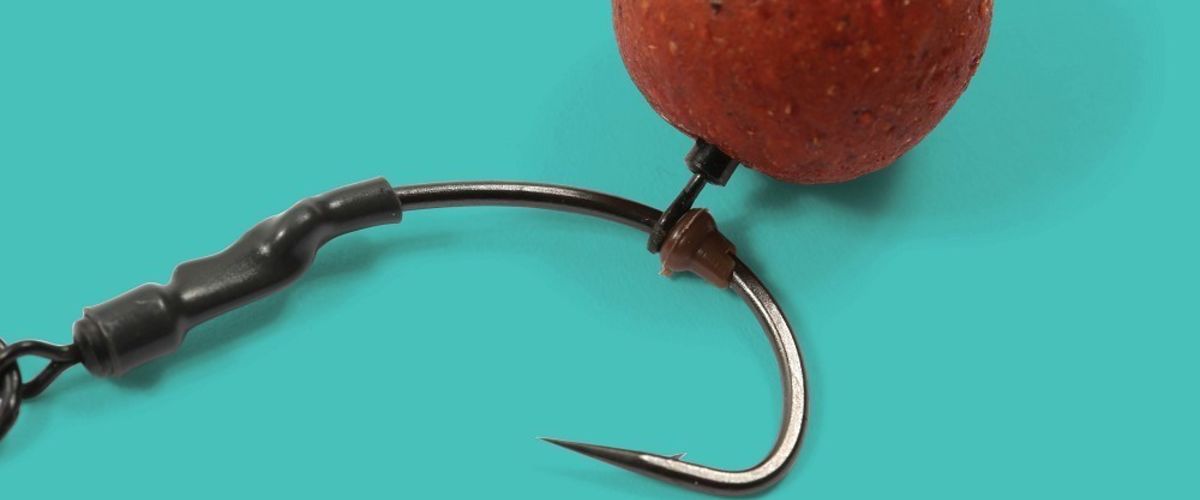
Everything you need to know about the Ronnie Rig
The mechanics are like that of the Hinged Stiff Rig – but with the benefit of offering precise low level subtle pop-up presentation and awesome hook holds.
I am 100% certain that the Ronnie is rig that will continue to work indefinitely like other key rigs that are just right from the outset. The mechanics are like that of the Hinged Stiff Rig – but with the benefit of offering precise low level subtle pop-up presentation and awesome hook holds.
The size 4 Covert Dark Mugga hook is (IMHO) the perfect hook for the Ronnie, simply because the 25-degree in-turned eye sets the XT Kwik Lok Flexi Ring in place at the optimum angle for the hook to react quickly and aggressively. The latest ‘Covert Dark’ incarnation of the pattern is simply phenomenal! The points have been totally re-profiled and are amazingly sharp – in fact, I would say no other curved pattern comes near.
By mounting the hookbait on a size 20 swivel or Flexi-Hook Swivel you’re ensuring that the hook can still rotate even if the fish clamps its mouth closed on the hookbait/hook. It’s a small detail but one of those little percentage improvements that all add up to ensure the rig works as well as it can it can.
Talking of fine details, the position of the Hook Stop is also quite critical. Unlike a 360ş Rig (yuk), the stop is positioned on the shank opposite the barb; we find it’s best positioned at the point where the shank is the furthest away on the sweep. This means the hooking function is enhanced and the rig acts more like a claw, giving super strong hook holds at least an inch inside the mouth and positioned either in the scissors or on the bottom lip.
The new Covert XT Flexi Ring Swivels makes positioning the swivel on the eye easier and they are stronger than the original clips (as they are designed for to do the job!) and this means they are easier to change/re-use.
Sleeving the connection with Supa-Shrink ensures that the position of the swivel is set at the most efficient angle – and cannot be affected by fish rolling or knocking the terminal tackle about (rolling or flanking across the spot).
That, in essence, is one of the key facets of the Ronnie: its ability to reset and remain absolutely effective presentation.
When and where
I’ve now used the rig in most situations: clear spots in weed, with large particles and with a spread of boilies and have found it worked faultlessly in all these angling situations.
I haven’t fished it over small seed (like hemp and parti-blend) but have no doubt that it would work with a shorter hooklink and perhaps a tiny bit of additional putty moulded around the shrink tube to stop it being wafted about due to the water displacement of feeding fish too much.
I have caught over gravel and silt – and just amend the lead arrangement and the hooklink length to suit different substrates. This decision on lead arrangements also dictates the hooklink material I choose. Basically, if the lakebed is relatively clean and/or I want to use a helicopter rig then I will use a monofilament hooklink, either Tricklink or one of the fluorocarbons we sell.
Little tricks
1. Just like many other pop-up rigs, the Ronnie really needs a decent pop-up – and personally I have found they work best with a small pop-up. The lovely little pink 12mm Caviar and Cranberry pop-ups I use are the perfect buoyancy – and require a small amount of putty.
2. If I am fishing in silt (or into the unknown, just feeling for a drop) I prefer to use a lead clip these days, combined with a long, soft skinned hooklink. The soft hooklink ensures that the hookbait isn’t held awkwardly up with the lead embedded in the silt or amongst weed/leaves.
3. If I think there is light debris I use a small meshed PVA bag with two boilies and hook the bag on (keeping the point clear) halfway along the bag – this keeps the hook point covered and ensures truly pukka presentation when the rig hits the lakebed.
Best session: The last year has been a whirl of big fish captures from several waters, and most my angling has been on the Ronnie. To call one as being better than another would be an injustice to the carp I have caught along the way.
Biggest carp landed on the rig: My biggest mirror that weighed 54 was on a Ronnie at the end of November. My last two captures of my biggest bommon, again 54lb, were on Ronnies. Last but not least, my biggest ghostie of 53lb was captured in February 2017 on one too!
Best run-to-take ratio: I have only lost one fish since I started using it (in pads). I don’t really count the numbers of carp so that’s a bit of a guess - but I would guess that’s a 50:1 ratio of big big fish…





